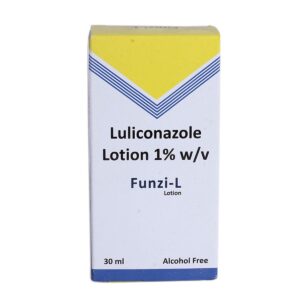NEOMYCIN-BACITRACIN-SULPHACETA + LULICONAZOLE
Neomycin-Bacitracin-Sulphaceta: Neomycin-Bacitracin-Sulphacetamide is a combination drug that consists of neomycin sulfate, bacitracin zinc, and sulphacetamide sodium. It is mainly used in the treatment of skin infections and eye infections caused by susceptible bacteria.
Neomycin is an aminoglycoside antibiotic that works by interfering with the bacterial protein synthesis. Bacitracin is a polypeptide antibiotic that inhibits the bacterial cell wall synthesis, and sulphacetamide is a sulfonamide antibiotic that disrupts the synthesis of folic acid in bacteria.
This combination drug is available as a topical ointment or cream for skin infections and as a solution for eye infections.
For skin infections, a thin layer of the ointment or cream should be applied to the affected area 2-4 times daily, after cleaning the area. For eye infections, usually, 1-2 drops of the solution are instilled into the affected eye(s) every 3-4 hours.
Like any medication, Neomycin-Bacitracin-Sulphacetamide may have side effects. Common side effects include skin irritation, itching, redness or rash at the application site. It is also possible to have an allergic reaction to the drug, which may manifest as severe itching, swelling, or difficulty breathing.
As with any antibiotic, there is a risk of developing antibiotic resistance with prolonged use. It is important to use this medication only as directed, and to complete the full course of treatment, even if the symptoms improve before completing the treatment.
It is recommended to consult a healthcare professional before using Neomycin-Bacitracin-Sulphacetamide, as they can provide individualized guidance based on the specific condition and medical history of the patient.
Luliconazole: Luliconazole is an antifungal medication that is used to treat various fungal infections of the skin, including athlete’s foot (tinea pedis) and ringworm (tinea corporis). It belongs to the azole class of antifungals.
The mechanism of action of Luliconazole involves inhibiting the production of ergosterol, which is an essential component of the fungal cell membrane. By disrupting the synthesis of ergosterol, Luliconazole weakens the fungal cell membrane, ultimately leading to the death of the fungus.
Luliconazole comes in the form of a cream or solution and is typically applied once daily to the affected area of the skin. The specific duration of treatment may vary depending on the type and severity of the infection.
Common side effects of Luliconazole may include itching, burning, redness, and irritation at the application site. These side effects are usually mild and tend to resolve on their own. In rare cases, more severe side effects such as allergic reactions or skin blistering may occur. It is important to seek medical attention if any concerning side effects occur.
It is advised to consult a healthcare professional before using Luliconazole, especially if you have any known allergies or medical conditions. They will be able to provide personalized advice and guidance regarding the appropriate use of this medication.



